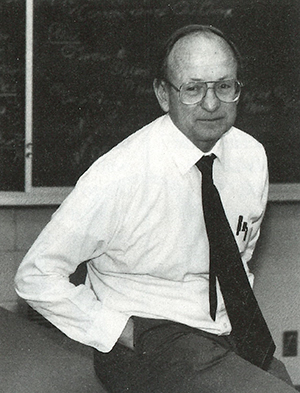A recession can be inspiration for entrepreneurs

The concept of the Weed Eater came to its inventor’s mind when he watched the spinning brushes in an automatic car wash.
A mother, looking for bread that would not trigger her son’s food allergy, creates a delicious product and establishes Pepperidge Farms.
A dance instructor, frustrated in his efforts to groom his lawn, attaches a wire-laced can to a lawn edger and the Weed Eater is born.
Two striking examples of entrepreneurship, says Professor Karl Vesper who, since 1969, has taught the subject in the UW School of Business.
“The term entrepreneurship is a really good word now,” Vesper observes. “It means good things like profit, innovation, job creation, self-fulfillment, all that good stuff.” Once upon a time the word carried negative connotations: excessive materialism, dishonesty, selfishness, he adds. “Now people hang it on all kinds of things where it doesn’t belong (such as when established companies expand into new areas) but they want to say something nice so they say ‘entrepreneurial.'”
Either way, new business is not without risk. According to Dun and Bradstreet, 1990 saw 647,000 new businesses incorporated and more than 50,000 go belly up. Of the record high 87,000 businesses which failed in 1991, 38 percent were five years old or less.
Starting a business with a well-known name may be a leg up but it usually comes with a price. Purchasing a Blockbuster Video franchise can run as high as $55,000, according to Entrepreneur magazine. A McDonald’s franchise costs about $22,500.
Some new businesses are born out of hobbies—someone who loves to knit might open a yarn shop. Others are created by bringing imagination to bear on a practical problem and then enlisting the services of someone with the technical skill to carry it out. The dance teacher who dreamed up the Weed Eater, for example, happened to own an apartment building. One of his tenants ran a machine shop.
But most entrepreneurs begin by working for somebody else in the same industry. Vesper calls it “industrial immersion” and likens it to post-medical school internship and residency training.
An Inc. magazine survey of the 500 fastest growing ventures revealed that 47 percent of ideas for new businesses arise from existing job or professional experience. Howard Head, dissatisfied with the performance of wooden skis, drew on his training and experience as an aeronautical engineer to design a ski made of metal and laminated plastic. Later, when competition from K2’s fiberglass product left Head’s ski enterprise in the dust, he sold out and went on to develop the Prince tennis racket.
Inc. also discovered that 15 percent of business opportunities come from making improvements on what someone else has done. Pepperidge Farm’s Margaret Rudkin, once she developed her new bread recipe, started baking extra loaves, which her husband took to his office colleagues. Then she offered them for sale in small specialty shops.
Eleven percent of entrepreneurs discover an unfilled niche in the consumer marketplace. George Ballas, dance instructor turned entrepreneur, actually stumbled on the concept of the Weed Eater in 1953 while watching the spinning brushes in an automatic car wash. Ballas didn’t act on his idea until 1971 when, in a moment of frustration over care of his own lawn, he punched holes in a can, shoved wire through the holes, and attached it to a standard edger. His creation flew apart within seconds but worked long enough to convince him that it could be done.
The ebb and flow of entrepreneurship within any given society or era depends on a broad mix of personal, political, technological, economic and social circumstances.
On the personal level, individuals can be either pushed or pulled into independent action. “A push is ‘You’re fired,’ ” Vesper explains. “A pull is ‘We think you’ve got great potential, we’d like to invest in you. We’ll put up the money, you start the company.’ ”
For a long time, Vesper believed that bureaucrats, who enjoy solid job security, were unlikely to be “pushed or pulled” into action. But he has changed his mind. “It turned out there were a whole bunch of companies in Alaska started by former bureaucrats,” he recalls. “When the pipeline hit, it was people who worked for the public health service who had practice building sewage systems that didn’t freeze in the permafrost. … Their skills all of a sudden had a free market value.”
Economic factors are a mixed bag. Recession-fueled layoffs at giant companies such as General Motors offer a “sort of a silver lining” of entrepreneurial opportunity in an otherwise dark scenario, he notes.
“They don’t have anything to lose because they’ve already lost their job, and there’s opportunity for them to try it because other people are failing and going out of business,” he says of recessionary layoffs. “But on the negative side … the money supply shrinks, people become more cautious and they don’t buy and investors are less willing to put money in risky investments.”
New technology also creates new markets and new opportunity. “When people discover you can make new products by gene splicing, then people who never were entrepreneurs before—namely biologists in white coats—suddenly become entrepreneurs,” says Vesper.
Advances in technology, such as microcomputers, also help create new levels of efficiency that further encourage entrepreneurship. “Small business operators (formerly) needed a bookkeeper, a secretary and a receptionist,” he says. “Now they’ve got an answering machine and a microcomputer and they can do all the same stuff.”
New machine technology has also made short-run production profitable, reducing the need for big up-front investment. “When I was in college, my old left-wing economic professors were telling me how the ham-handed, cigar-chewing, money-grabbing capitalists basically had us all by the throat because that person controlled the factors of production,” he recalls. “We couldn’t compete with U.S. Steel because they’ve got the big plant. It turned out to be 180 degrees wrong. U.S. Steel was doomed because it had the big plant. The little flexible guys could eat them alive because of new technology.”

Karl Vesper
Specific social changes also generate new opportunity. As the population ages, for example, it creates a need for more health care facilities and nursing homes. And broad social changes, such as a society-wide rebellion against central authority, also foster entrepreneurship. “The decline of the Catholic church, I think is a symptom,” Vesper notes. “People (are) saying ‘We don’t want to accept central authority anymore.’ ”
Self-determination is replacing mass action. Some big companies are reorganizing into smaller units. “So you have Hewlett Packard saying ‘We won’t have any business unit larger than X-hundred employees,’” he adds.
One omnipresent central authority—government—can encourage entrepreneurship directly, through favorable public policy, or indirectly, by handicapping larger companies with regulations. A large firm faces occupational safety rules, workers’ compensation constraints and health insurance requirements.
When that happens the entrepreneur, with a one-person business, may be able to execute what Vesper calls an “end run” around the costly red tape.
Vesper is reluctant to predict what impact, if any, the economic policies of the Clinton administration will have on entrepreneurship. He will make one generalization, however: government clout and red tape can hamper entrepreneurs.
The U.S. Postal Service enjoys a monopoly over what goes into your mailbox. It has gone to court to put some entrepreneurial private mail services out of business. Federal legislation can be an obstacle, such as the Davis-Bacon Act barring firms with independent workers from federal construction projects. Minimum wage laws can hamper fledgling business. So can the cost and red tape in obtaining patents. Government also inhibits entrepreneurship when it bails out big business, such as Lockheed and Penn Central.
If the government wants to help, Vesper suggests that it could allow workers who quit their jobs to collect unemployment while pursuing a startup business. That benefit would only apply for a limited number of months, he adds.
As it is, government doesn’t help entrepreneurs nearly to the extent it supports small businesses already in operation which, Vesper notes, are not the same thing. “Entrepreneurship calls for different initiatives, namely programs which help qualified ‘outs’ become ‘ins’ of business ownership, in contrast with programs that simply help the ‘ins’ to stay in,” he says.
Vesper, a professor of management, mechanical engineering and marine studies, has never been an entrepreneur himself. He earned a bachelor’s degree in mechanical engineering from Stanford in 1955, an M.B.A. from Harvard in 1960 and then a master’s and Ph.D. in mechanical engineering back at Stanford.
He came to the UW in 1969 holding a joint appointment in business and mechanical engineering and determined to create a class that combined both fields. It didn’t work. “It just wasn’t possible on this campus, even if the two schools had been (physically) close together, which they’re not. … But I had started an entrepreneur class here as part of that activity.”
Until recently, Vesper has felt like a voice crying in the wilderness. After years of seeing his own research proposals turned down, Vesper notes, the school is belatedly waking up to the value of entrepreneurship in curriculum and research. And they’re doing it, at least in part, for the best of all entrepreneurial reasons: It pays. “There’s money out there among alumni and others to do this sort of thing,” says Vesper.
Early signs include the establishment of an entrepreneurship program in the school’s management and organization department. Beyond the ivory tower, the UW’s Second Annual Symposium for Entrepreneurial Excellence recently brought together UW faculty and CEOs of several companies to offer business seminars.
When Vesper came to campus only 16 business schools in the U.S. offered entrepreneurship courses. Today, 350 to 400 schools hold at least one class about starting your own business.
At the UW, many students take his classes because they eventually want to own their own business. What Vesper gives them is the chance to try out entrepreneurial skills. His exercises encourage what he calls “projective thinking” as students create and manage a nonexistent company. It’s a refreshing change from the standard business-school model that studies companies which already exist.
Once in a while he encounters a student who is a bit ahead of the curve. “I had a student last quarter who was exporting used cars,” Vesper says. “He shipped them to Finland and a friend of his came from Moscow and took them to Russia.” After graduating from the UW this particular entrepreneur “hightailed it to Florida,” Vesper adds, because he found he could ship them cheaper from Florida than Seattle. Clearly, he learned his lessons well.
Business education, experience, clear vision, imagination and good common sense are a big help when someone decides to strike out on his or her own. But Vesper puts little credence in the idea of an entrepreneurial personality. The mother who founded Pepperidge Farms wasn’t necessarily a risk-taker, she just had a problem that needed solving.
Vesper also cautions against the media’s tendency to glamorize entrepreneurship—placing too much emphasis on taking risks and closing deals. Stars of TV commercials, such as Victor Kiam (owner of the New England Patriots and the company that makes Remington electric shavers), capitalize on personal charisma and sometimes become household names. But Kiam—who is also an excellent businessman, Vesper emphasizes—is an exception. The real key to entrepreneurial success is offering a product or service people want.
Microsoft founder Bill Gates, for example, had the skill and imagination to make things for computers that people wanted to buy, Vesper notes. “That isn’t charisma, it isn’t magic, it isn’t charm, guts or spirit,” he adds. “I sometimes think that in all the hoopla entrepreneurship gets, people overplay the charisma factor and underplay the Gates factor.”